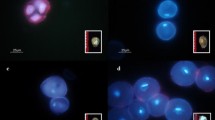Abstract
The present study evaluated the individual plants reaction of F2 hybrid generation of C. annuum: ATZ1 × PO and ATZ1 × CDT as well as two interspecific hybrids: C. frutescens × C. annuum ATM1 and C. frutescens × C. chinense on androgenesis conditions in in vitro anther cultures. The experiment was carried out following a modified method of Dumas de Vaulx et al. (Agronomie 1:859–864, 1981). There were demonstrated clear differences in the effectiveness of androgenesis both between the pepper hybrid forms as well as among individual plants of all the genotypes tested. The highest effectiveness of androgenic embryos development was observed for the cultivated form of C. annuum: (ATZ1 × PO)F2. Anthers of most of the plants of this hybrid produced embryos at the level higher than 5%, while in anther cultures of the second C. annuum hybrid (ATZ1 × CDT)F2 almost 3-fold fewer embryos and plants were produced. Anthers isolated from flower buds of interspecific hybrids formed much lower number of embryos. A positive reaction was recorded for five hybrid plants of (C. frutescens × C. annuum ATM1)F2, while in case of (C. frutescens × C. chinense)F2 androgenic embryos were obtained from anthers of two plants. Only in the case of a one of these plants did the effectiveness of androgenesis exceed 5%. The ploidy level of the regenerants was determined by flow cytometry. Among the regenerants there were observed both haploid forms and the plants with the diploid number of chromosomes.


Similar content being viewed by others
References
Choo TM (1981) Doubled haploid for studying the inheritance of quantitative characters. Genetics 99:525–540
Descriptors for Capsicum (Capsicum spp.) (1995) International Plant Genetic Resources Institute, Rome
Dumas de Vaulx R, Chambonnet D, Pochard E (1981) Culture in vitro d’anthéres de piment (Capsicum annuum L.) amélioration des taux d’obtention de plantes chez différents génotypes par des traitements á +35°C. Agronomie 1:859–864. doi:10.1051/agro:19811006
Ercan N, Sensoy FA, Sensoy AS (2006) Influence of growing season and donor plant age on anther culture response of some pepper cultivars (Capsicum annuum L.). Sci Hortic (Amsterdam) 110:16–20. doi:10.1016/j.scienta.2006.06.007
Galbraith DW, Harkins KR, Maddox JM, Ayres NM, Sharma DP, Firoozabady E (1983) Rapid flow cytometry analysis of the cell cycle in intact plant tissues. Science 220:1049–1051. doi:10.1126/science.220.4601.1049
Kim M, Jang IC, Kim JA, Park EJ, Yoon M, Lee Y (2008) Embryogenesis and plant regeneration of hot pepper (Capsicum annuum L.) through isolated microspore culture. Plant Cell Rep 27(3):425–434. doi:10.1007/s00299-007-0442-4
Kristiansen K, Andersen SB (1993) Effects of donor plant, temperature, photoperiod and age on anther culture response of Capsicum annuum L. Euphytica 67:105–109. doi:10.1007/BF00022732
Mitykó J, Andrásfalvy A, Csilléry G, Fári M (1995a) Anther-culture response in different genotypes and F1 hybrids of pepper (Capsicum annuum L.). Plant Breed 114:78–80. doi:10.1111/j.1439-0523.1995.tb00764.x
Mitykó J, Chambonnet D ádám G, Andrásfalvy A, Fári M (1995b) In vitro haploidy of spice and bell peppers: its control for large-scale application. In: Proceedings of IXth EUCARPIA meeting on genetics and breeding of Capsicum & Eggplant, Budapest, pp 64–67
Morrison RA, Koning RE, Evans DA (1986) Anther culture of an interspecific hybrid of Capsicum. J Plant Physiol 126:1–9
Munyon IP, Hubstenberger JF, Phillips C (1989) Origin of plantlets and callus obtained from chile pepper anther cultures. In Vitro Cell Dev Biol 25(3):293–296. doi:10.1007/BF02628469
Novák FJ (1974) Induction of a haploid callus in anther cultures of Capsicum sp. Z Pflanzenzucht 72:46–54
Nowaczyk P, Kisiała A (2006) Effect of selected factors on the effectiveness of Capsicum annuum L. anther culture. J Appl Genet 47(2):113–117
Nowaczyk P, Kisiała A, Olszewska D (2006) Induced androgenesis of Capsicum frutescens L. Acta Physiol Plant 28(1):35–39. doi:10.1007/s11738-006-0066-2
Pundeva R, Zagorska N, Simeonova N (1989) Study of induced callus- and embryogenesis in anther cultures of pepper. Gen Seleksiya 23(2):137–145
Supena EDJ, Suharsono S, Jacobsen J, Custers JBM (2006) Successful development of a shed-microspore culture protocol for doubled haploid production in Indonesian hot pepper (Capsicum annuum L.). Plant Cell Rep 25(1):1–10. doi:10.1007/s00299-005-0028-y
Author information
Authors and Affiliations
Corresponding author
Rights and permissions
About this article
Cite this article
Nowaczyk, P., Olszewska, D. & Kisiała, A. Individual reaction of Capsicum F2 hybrid genotypes in anther cultures. Euphytica 168, 225–233 (2009). https://doi.org/10.1007/s10681-009-9909-4
Received:
Accepted:
Published:
Issue Date:
DOI: https://doi.org/10.1007/s10681-009-9909-4




